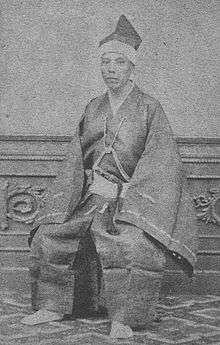Matsudaira Mochiaki
In this Japanese name, the family name is Matsudaira.
| Matsudaira Mochiaki | |
|---|---|
 Matsudaira Mochiaki | |
| Lord of Fukui | |
|
In office 1858–1871 | |
| Preceded by | Matsudaira Yoshinaga |
| Succeeded by | none |
| Personal details | |
| Born | September 17, 1836 |
| Died | July 25, 1890 (aged 53) |
| Nationality | Japanese |
| Spouse(s) | Takatsukasa Kayo, later Kuga Yukiko |
Matsudaira Mochiaki (松平 茂昭, 17 September 1836–25 July 1890) was a Japanese daimyo of the late Edo period. He was the last head of the Fukui Domain in Echizen Province.[1]
Daimyo
Mochiaki first ruled the Itoigawa Domain. He was adopted by Matsudaira Yoshinaga.
When Yoshinaga gave up his title and power, Mochiaki became the head of the Fukui Domain.[1]
Meiji period
After the daimyo were abolished, he was made an Imperial governor of Fukui.[2]
Mochiaki was made a member of the new Meiji aristocracy (kazoku). He was created a count; and he was promoted to marquis in 1888.[3]
See also
References

Emblem (mon) of the Matsudaira clan
- 1 2 Burks, Ardath W. (1985). The Modernizers: overseas students, foreign employees, and Meiji Japan, p. 61; excerpt Matsudaira Yoshinaga "abdicated the lordship of Fukui to his remote relative Mochiaki (daimyo 1858-1871)"
- ↑ Griffis, William Elliot. (1883). The Mikado's Empire, p. 428.
- ↑ "Summary of the News," The Japan Weekly Mail, Vol. IX, No, 3 (January 21, 1888), P. 46, 1st column; excerpt, "Counts Matsudaira Mochiaki, Nakanomikado Tsuneakira, and Saga Kinto have been promoted to the rank of Marquis, in recognition of services rendered by their fathers to the Government"; retrieved 2013-4-9.
External links
- "Fukui" at Edo 300 (Japanese)
- 越前松平氏 (Echizen Matsudaira) at ReichsArchiv.jp (Japanese)
| Preceded by Matsudaira Naoharu |
Daimyo of Itoigawa 1857-1858 |
Succeeded by Matsudaira Naoyasu |
| Preceded by Matsudaira Yoshinaga |
Daimyo of Fukui 1858-1871 |
Succeeded by domain is abolished |
This article is issued from Wikipedia - version of the 7/6/2016. The text is available under the Creative Commons Attribution/Share Alike but additional terms may apply for the media files.